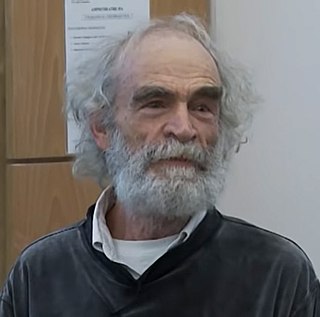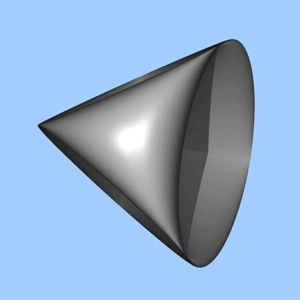Related Research Articles
Riemannian geometry is the branch of differential geometry that studies Riemannian manifolds, defined as smooth manifolds with a Riemannian metric. This gives, in particular, local notions of angle, length of curves, surface area and volume. From those, some other global quantities can be derived by integrating local contributions.
Hopf–Rinow theorem is a set of statements about the geodesic completeness of Riemannian manifolds. It is named after Heinz Hopf and his student Willi Rinow, who published it in 1931. Stefan Cohn-Vossen extended part of the Hopf–Rinow theorem to the context of certain types of metric spaces.

Mikhael Leonidovich Gromov is a Russian-French mathematician known for his work in geometry, analysis and group theory. He is a permanent member of Institut des Hautes Études Scientifiques in France and a professor of mathematics at New York University.

In mathematics, systolic geometry is the study of systolic invariants of manifolds and polyhedra, as initially conceived by Charles Loewner and developed by Mikhail Gromov, Michael Freedman, Peter Sarnak, Mikhail Katz, Larry Guth, and others, in its arithmetical, ergodic, and topological manifestations. See also Introduction to systolic geometry.
In the mathematical field of metric geometry, Mikhael Gromov proved a fundamental compactness theorem for sequences of metric spaces. In the special case of Riemannian manifolds, the key assumption of his compactness theorem is automatically satisfied under an assumption on Ricci curvature. These theorems have been widely used in the fields of geometric group theory and Riemannian geometry.

Jeff Cheeger is an American mathematician and Silver Professor at the Courant Institute of Mathematical Sciences of New York University. His main interest is differential geometry and its connections with topology and analysis.
In mathematics, in particular in differential geometry, the minimal volume is a number that describes one aspect of a smooth manifold's topology. This diffeomorphism invariant was introduced by Mikhael Gromov.
In differential geometry, Loewner's torus inequality is an inequality due to Charles Loewner. It relates the systole and the area of an arbitrary Riemannian metric on the 2-torus.

In differential geometry, Pu's inequality, proved by Pao Ming Pu, relates the area of an arbitrary Riemannian surface homeomorphic to the real projective plane with the lengths of the closed curves contained in it.
In Riemannian geometry, Gromov's optimal stable 2-systolic inequality is the inequality
In the mathematical field of Riemannian geometry, M. Gromov's systolic inequality bounds the length of the shortest non-contractible loop on a Riemannian manifold in terms of the volume of the manifold. Gromov's systolic inequality was proved in 1983; it can be viewed as a generalisation, albeit non-optimal, of Loewner's torus inequality and Pu's inequality for the real projective plane.
In differential geometry, Mikhail Gromov's filling area conjecture asserts that the hemisphere has minimum area among the orientable surfaces that fill a closed curve of given length without introducing shortcuts between its points.

Marcel Berger was a French mathematician, doyen of French differential geometry, and a former director of the Institut des Hautes Études Scientifiques (IHÉS), France.
In Riemannian geometry, the filling radius of a Riemannian manifold X is a metric invariant of X. It was originally introduced in 1983 by Mikhail Gromov, who used it to prove his systolic inequality for essential manifolds, vastly generalizing Loewner's torus inequality and Pu's inequality for the real projective plane, and creating systolic geometry in its modern form.

Systolic geometry is a branch of differential geometry, a field within mathematics, studying problems such as the relationship between the area inside a closed curve C, and the length or perimeter of C. Since the area A may be small while the length l is large, when C looks elongated, the relationship can only take the form of an inequality. What is more, such an inequality would be an upper bound for A: there is no interesting lower bound just in terms of the length.
In mathematics, systolic inequalities for curves on surfaces were first studied by Charles Loewner in 1949. Given a closed surface, its systole, denoted sys, is defined to be the least length of a loop that cannot be contracted to a point on the surface. The systolic area of a metric is defined to be the ratio area/sys2. The systolic ratio SR is the reciprocal quantity sys2/area. See also Introduction to systolic geometry.
In differential geometry, systolic freedom refers to the fact that closed Riemannian manifolds may have arbitrarily small volume regardless of their systolic invariants. That is, systolic invariants or products of systolic invariants do not in general provide universal lower bounds for the total volume of a closed Riemannian manifold.
Lawrence David Guth is a professor of mathematics at the Massachusetts Institute of Technology.
In mathematics, the Besicovitch inequality is a geometric inequality relating volume of a set and distances between certain subsets of its boundary. The inequality was first formulated by Abram Besicovitch.
References
- 1 2 3 Curriculum vitae [ permanent dead link ], retrieved 2011-05-23.
- ↑ Kalogeropoulos, Nikolaos (2017). "Systolic aspects of black hole entropy". arXiv: 1711.09963 [gr-qc].
- ↑ Chavel, Isaac (2006-04-10). Riemannian Geometry: A Modern Introduction. Cambridge University Press. ISBN 978-1-139-45257-1.
- ↑ "Clara Katz, a Soviet émigré who saved her ailing granddaughter, dies at 85 – The Boston Globe". archive.boston.com. Retrieved 2018-01-10.
- ↑ "Grandmother bucked the Soviet system – Obituaries – smh.com.au". www.smh.com.au. 12 October 2006. Retrieved 2018-01-10.
- ↑ Mikhail Katz at the Mathematics Genealogy Project
- ↑ Gromov, Misha: Metric structures for Riemannian and non-Riemannian spaces. Based on the 1981 French original. With appendices by M. Katz, P. Pansu and S. Semmes. Translated from the French by Sean Michael Bates. Progress in Mathematics, 152. Birkhäuser Boston, Inc., Boston, MA, 1999. xx+585 pp. ISBN 0-8176-3898-9
- ↑ Berger, M.: What is... a Systole? Notices of the AMS 55 (2008), no. 3, 374–376.
- ↑ Stewart, I. (2009) Professor Stewart's Hoard of Mathematical Treasures, Profile Books, p. 174.